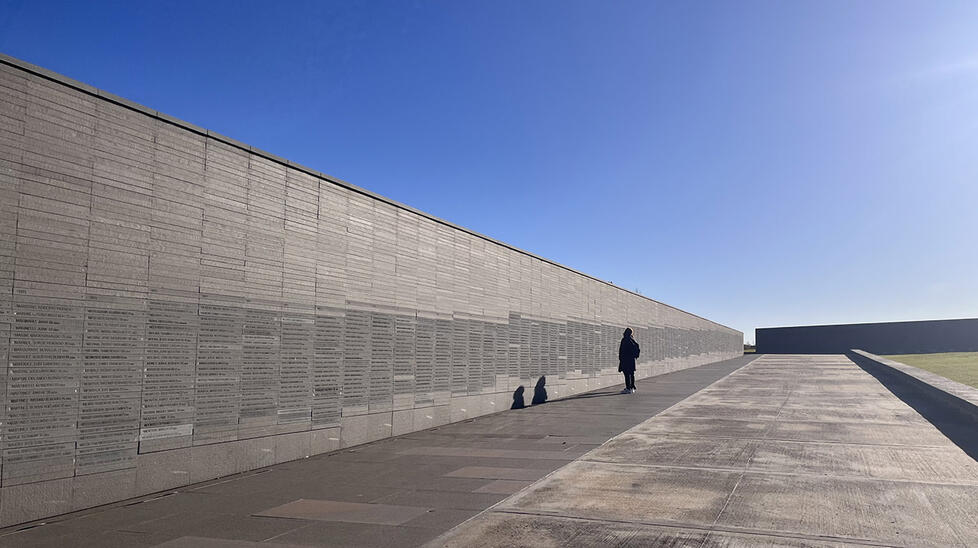Living on the Edge in the Immersive Princeton in Argentina Course
When I signed up for Princeton in Argentina, I never imagined the summer course would involve hanging off the side of a cliff in the Andes Mountains, looking over a creek of running water with mountain goats peering at me from above.
Throughout our two-and-a-half-hour hike, I was convinced my first time outside of the U.S. would be my last. Our Indigenous tour guide, clad in well-worn tennis shoes, held out his hands for each of us to step into, helping us jump off a boulder and onto a landing. The view was of a small, glistening waterfall hidden within the large rocks.
While I told myself I could not climb any farther up the mountain, my classmates encouraged me through every step, and when we finished our rock scrambling after multiple falls, scrapes, and drenched socks, we took a collective sigh of relief, stepping onto solid land.
“I definitely thought we were going to die,” I told my roommate as we returned to the bus, to which she added, “They absolutely cannot do that next year.”
I had applied to the Princeton in Argentina program in February, and by the time I stepped off the plane in late May for my first trip abroad, my nerves were fluttering. The majority of the 18 students who made up our cohort were strangers.
At the airport, my host mother, Cecilia, kissed me on the cheek — a common greeting for the affectionate people of Buenos Aires — but my first instinct was to pull back in puzzlement. After my roommate arrived, Cecilia drove us into the artsy district of Palermo, where we would spend the next month living as intercambio students.
Her rustic, 20-foot-high ceiling apartment, tucked behind a skinny doorway, was as colorful as it was cold (winter was about to begin in the southern hemisphere). Most nights I wore thick pants, a sweatshirt, and wool socks as the rooms seemed to never heat fast enough. I was grateful to spend evenings with my roommate in the cozy living room with an antique furnace.
At the University Torcuato Di Tella, a modern school next to the coast, the local students almost immediately knew we were American just by looking at us, and in a class just among ourselves, our cohort soon became fast friends as we navigated city life and tried to stay vigilant to avoid the rampant pickpocketing we were constantly warned about. While the course load was demanding — as expected from any Princeton class — we had a successful crash course on Argentina’s history, from its founding to its most recent feminist movement. Occasionally, our Princeton professors scheduled lectures with local experts to introduce us to Argentina’s relationship with its Indigenous history and global relations, complemented by group visits to local museums.
One Thursday afternoon unexpectedly opened the door to Argentina’s dark history with state terrorism as the Madres de la Plaza de Mayo began protesting in front of the Casa Rosada while we toured the Plaza de Mayo. A group of protesters began circulating and calling out the names of students who disappeared in the 1970s. An elderly woman stepped out of a van and began walking with them. “That’s one of the mothers of the disappeared — they have come every Thursday for over 40 years,” our tour guide said. Our later, very memorable visit to the Sitio de Memoria exposed us to the thousands of missing young students — “students your age” as our professors would remind us — who disappeared under the military regime and thrown out of planes in the river right in front of us. The visit allowed me to see the depth of a country I had barely known but now desired an infinite amount of time to learn more about.
Our month in Buenos Aires included a weekend excursion to the northern province of Salta, known for its strong Indigenous influence. With its real-life gauchos, vibrant churches, and tranquil atmosphere, it was a world away from the bustling streets of the “Paris of South America,” where we’d spent our first two weeks. In three days away from the city, we were driven around on a passenger bus through picturesque views of Cafayate, its red-hued canyons and expansive vineyards lacing both sides of the road.
We experienced the epitome of “community-based tourism” as our guides introduced us to local families, multigenerational vineyard owners, and Indigenous leaders. We visited the Quilmes ruins in the Tucumán province. We shared meals curated by local chefs — including empanadas, colorful plates of meat, the traditional Locro dish, and an elevated applesauce dessert. We stayed at the beautiful Iraola Hotel, a colonial-style farmhouse. Nights were spent walking around the town square, gathering in each other’s rooms, or sitting in the cold looking at the stars I had never seen more clearly in the sky.
In the last week of June, after final group presentations and a last meal, we said our goodbyes. Pulling away as Cecilia waved from the doorstep, I smiled at the contentment in place of sadness that I felt. If I could do it over again — I wouldn’t. But only because it wouldn’t be with the same people at the same point in time; the feeling of living on the edge, in a city at the end of the world, was a once-in-a-lifetime experience.













No responses yet